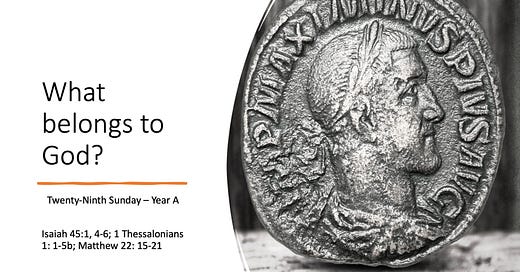Isaiah 45:1, 4-6; 1 Thessalonians 1: 1-5b; Matthew 22: 15-21
"Though you knew me not" (Is. 45:5). The first reading surprises us with a message that a pagan king of Persia, Cyrus, who does not know God, is chosen to free Israel and other nations from the despotic rule of the Babylonian kings (Is. 45:4). In 539 BC, Cyrus defeated Babylon, and a year later issued an edict allowing the Jews exiled to Babylon to return to Jerusalem and rebuild the temple (2 Chron. 36:22-23). Indeed God does not regard a person's status (Matt. 22:16), but "in every nation anyone who fears him and does what is right is acceptable to him" (Acts 10:35).
Before God made a covenant with Abraham, he made a covenant with Noah who represented all humankind, and until the universal proclamation of the Gospel, this covenant remains in force (CCC, 58). Cyrus is an example of how living by this covenant one can become an instrument for good in God's hands. On the other hand, the Pharisees with their hypocritical attitude show that the covenant which God established with Israel in the time of Moses does not guarantee personal sanctity.
"Is it lawful to pay taxes to Caesar, or not?" (Matt. 22:17). Yes, it is (Rom. 13:1-7). A similar tax was paid by the Jews living in the land of Israel during the Persian Empire (Neh. 5:4). The Pharisees, however, were not interested in taxes but in entrapping Jesus in speech (Matt. 22:15). They did not approach Jesus with the fear of the Lord but with a heart full of deceit (Sirach 1:30). However, the Lord, who examines human heart (Jer. 19:10), discerns hypocrisy hidden behind their beautiful words (Matt. 22:16-18).
"Show me the coin for the tax" (Matt. 22:19). On a denarius minted by the Roman emperor, one could see his image. And whose image is in a man? We were created in the image of God (Gen. 1:27), but now we bear the image of Adam, the earthly man (1 Cor. 15:49) who is prone to sin. However, the One who placed his image in us came to recover it. Render "to God what belongs to God" (Matt. 22:21) is a call to be conformed to the image of the Son of God (Rom. 8:29). God wants us to bear the image of the heavenly man (1 Cor. 15:49).
"The vocation of humanity is to show forth the image of God and to be transformed into the image of the Father's only Son" (CCC, 1877). The preaching of the Gospel serves this purpose. By proclaiming to the nations that Jesus Christ, through his death on the cross, liberated the whole world from the despotic rule of sin, the apostles of the Lamb lead us to faith and baptism, in which we are marked with the seal of the Holy Spirit (2 Cor. 1:22; Eph. 4:30). From that moment we became the temple of the Holy Spirit; we no longer belong to ourselves but God (1 Cor. 6:19).
We get transformed from the image of Adam into the image of Christ through the work of faith, the labor of love, and enduring hope (1 Thess. 1:3). Faith is an obedient response to God's revelation (Rom. 1:5), of which the best examples are Abraham and the Blessed Virgin Mary. Love does not harm others, it is the fulfillment of the law and it never ends (Rom. 13:10; 1 Cor. 13:8). Finally, hope allows us patiently await the purpose of our faith - "the redemption of our bodies" (Rom. 8:23).
Everyone belongs to God, even those who, like Cyrus, do not know God. But God wants to be known. Therefore the Church proclaims the Gospel to all “with full conviction” (1 Thess. 1:5), so that everyone may know the One God, the Lord of history and the world, and be saved.




